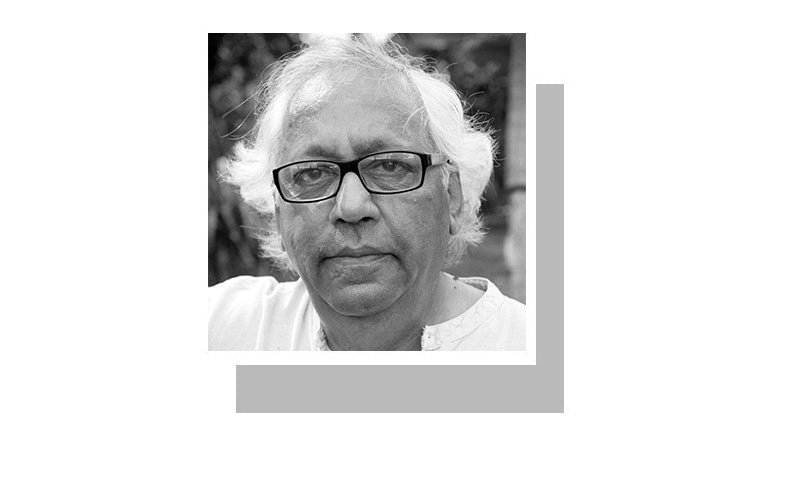
… AND they are off! The front runner has been turbo-charged by the racing club management that has hobbled the next horse. Bringing up the rear is a thoroughbred that has seen better times, but is now way past its peak.
This scenario is what we see from the echo chamber that much of our media has become. But the other day as I was flipping channels, I came across an interesting two-part interview with Dr Ijaz Gilani, founder and chairman of Gallup Pakistan.
I was so fascinated by the facts and figures he discussed that I watched the programme online the next day so I could take notes. Relying on data from all the elections held in Pakistan from 1970 onwards, he made the point that while there had been rigging against the PPP in the 1988 and 1993 polls, it was no longer possible to doctor the results on election day.
Another point Dr Gilani made was that while only 15 per cent of voters were influenced by the personal appeal of leaders, 85pc of them voted for parties. This would seem to minimise the impact of Imran Khan’s undeniable charisma. In terms of personal popularity, Gallup Pakistan’s findings are that Nawaz Sharif leads Imran Khan by 50pc to 45pc.
The figures reveal that we are talking about two Pakistans.
Overall, the PTI’s support has increased from 17pc in the 2013 elections to 25pc in the most recent Gallup poll. In the same period, the PML-N has gone up from 33pc to 38pc. The PPP remains stagnant at around 15pc.
But it is in Punjab that the gap between the two top parties is widest: Gallup Pakistan puts the PML-N far ahead with a 20pc lead over PTI. This difference, if translated into assembly seats, would almost certainly make PML-N the biggest parliamentary party, and therefore in the best position to form the next government. In KP, the PTI’s appeal has risen, while PPP continues to dominate in rural Sindh. Karachi has become extremely volatile, with voter intentions changing from day to day.
When Gallup Pakistan published its forecast before the 2013 elections, placing the PTI far behind PML-N, Imran Khan dismissed the polling organisation as politically motivated. But Dr Gilani’s outfit has been remarkably accurate in predicting the results in 2008 and 2013.
Political forecasters have earned a bad name following Donald Trump’s surprise win in 2016, and the shock victory of the Leave campaign in the Brexit referendum. But in terms of the popular vote, pollsters had Hilary Clinton ahead by a large margin; in the event, she received nearly three million more votes than Trump, only to be defeated in the electoral college.
If Dr Gilani’s numbers turn out to be accurate in the coming elections, what will it mean for Imran Khan? Will we have to endure another five years of destabilising rigging charges, appeals, court cases, long marches and sit-ins? Should Imran Khan fail to achieve his dream of becoming prime minister again, despite all the help he has allegedly received from the establishment, his frustration will know no bounds.
Just as relevant is the question of what a PML-N victory will mean for an establishment that has tried every trick in the book to prevent the party’s victory by a concerted campaign to blacken Nawaz Sharif’s name. But even after he was unseated as prime minister on flimsy grounds, his party remains popular in Punjab. And as we have noted earlier, 85pc of voters cast their ballots for a party, and not a leader.
These polling figures also underline what some of us have said before: allegations of corruption do not greatly influence voters, most of whom look at the performance of local politicians as well as their parties. And here, the PML-N is widely perceived to have delivered in Punjab.
So why this huge gap between the perceptions of actual voters and the chattering classes who inhabit the bubble created by TV chat shows? Dr Gilani has an explanation: according to his data, 70pc of those polled indicate that they are satisfied that Pakistan is headed in the right direction. This is in stark contrast to the media babble about doom and gloom, and how we are in freefall.
Clearly, then, we are talking about two Pakistans here: one comprising around 10pc of the population that consists of the educated middle class with high aspirations, and the vast majority of people who are relatively poor, but who want a better life for their children. Unsurprisingly, it is this second group that ultimately decides the outcome of elections. For them, elections are the only means for their voices to be heard, and they vote in large numbers.
All this is undoubtedly bad news for our political engineers who need to internalise the lessons hard numbers teach us. Wishful thinking, not backed by data and rigorous analysis, is not enough to base strategy on. Luckily, Dr Gilani has provided us with both.
Memo to PTI trolls: Please don’t shoot the messenger.
Published in Dawn, May 26th, 2018











































